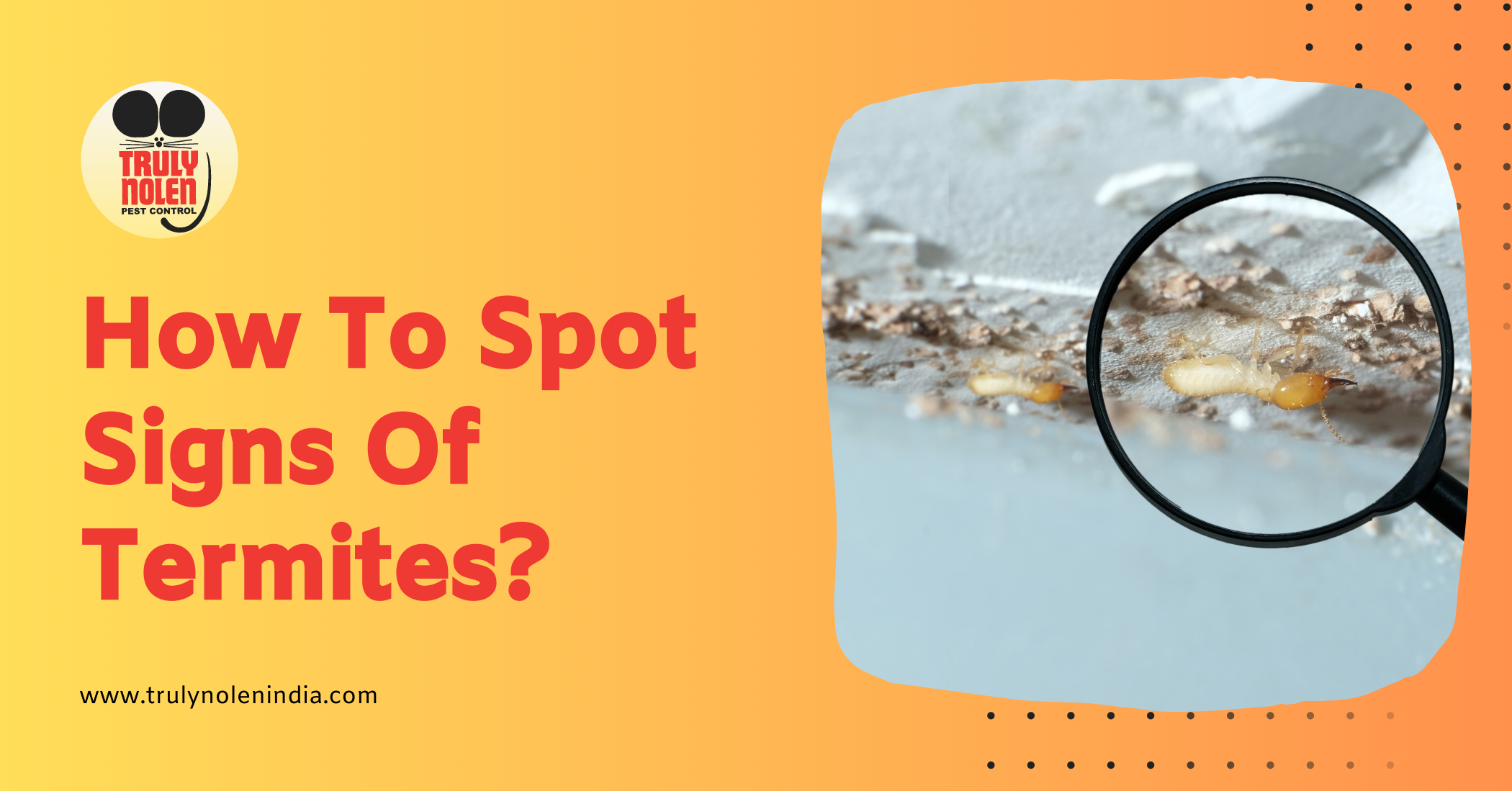
Pests can be really sneaky creatures. A little mouse can have a unique talent for squeezing through tiny cracks and finding its way into pantry items. Sometimes even cockroaches can find their way into our homes through vents, and spiders can invade themselves in the corners of rooms and leave their webs behind. But among all these, termites are the sneakiest creatures and can cause severe damage. Have you ever wondered, “How do I know if I have termites?”
Finding severe termite damage can be very stressful for any homeowner. So it’s imperative to recognize the signs of a termite infestation as early as possible, so you can take action and minimize any damage they might cause.
While other pests leave obvious signs, termites can be tricky because they often don’t leave any visible signs. They can quietly feed on a home’s wood for years, or even decades, without even getting noticed. But there are signs that termites leave behind if you know where and how to look for them!
In this blog, we are here to help you learn how to spot signs of termites, what causes termite infestation, and how to prevent pesky termites.
All About Termite
Termites are tiny insects that feed on wood. Their life span can range from 2 to 50 years. A colony of termites can actually have more than a million individual members. However, there are different types of termites out there, each with their own unique features and preferences. No matter the type, they all tend to leave behind the same signs when they decide to invade your house.
But did you know that termites are actually called “silent destroyers”? It’s because they have this amazing ability to chew through wood, flooring, and even wallpaper without anyone noticing.
What Do Termites Look Like?
You may wonder, What does a termite look like? Where do they live? How can you tell if you’ve got termites? Termites can vary in size, ranging from about one-eighth of an inch to one inch long. They can come in all sorts of colors.
Depending on what type, species, and age they are, you might see shades of white, brown, or black. It’s actually common for people to mistake termites for flying ants. They both have wings and antennae, which can make them look similar.
Termites can actually look quite different from each other. Their appearance can vary a lot depending on the species they belong to and the role they play within their colony. Termite colonies are made up of several castes, including:
- Workers: Take care of eggs, maintain the colony, and look for food
- Soldiers: Guard the colony
- Reproductives (swarmers or alates): Leave the colony to mate and establish new colonies
What Causes Termite Infestation?
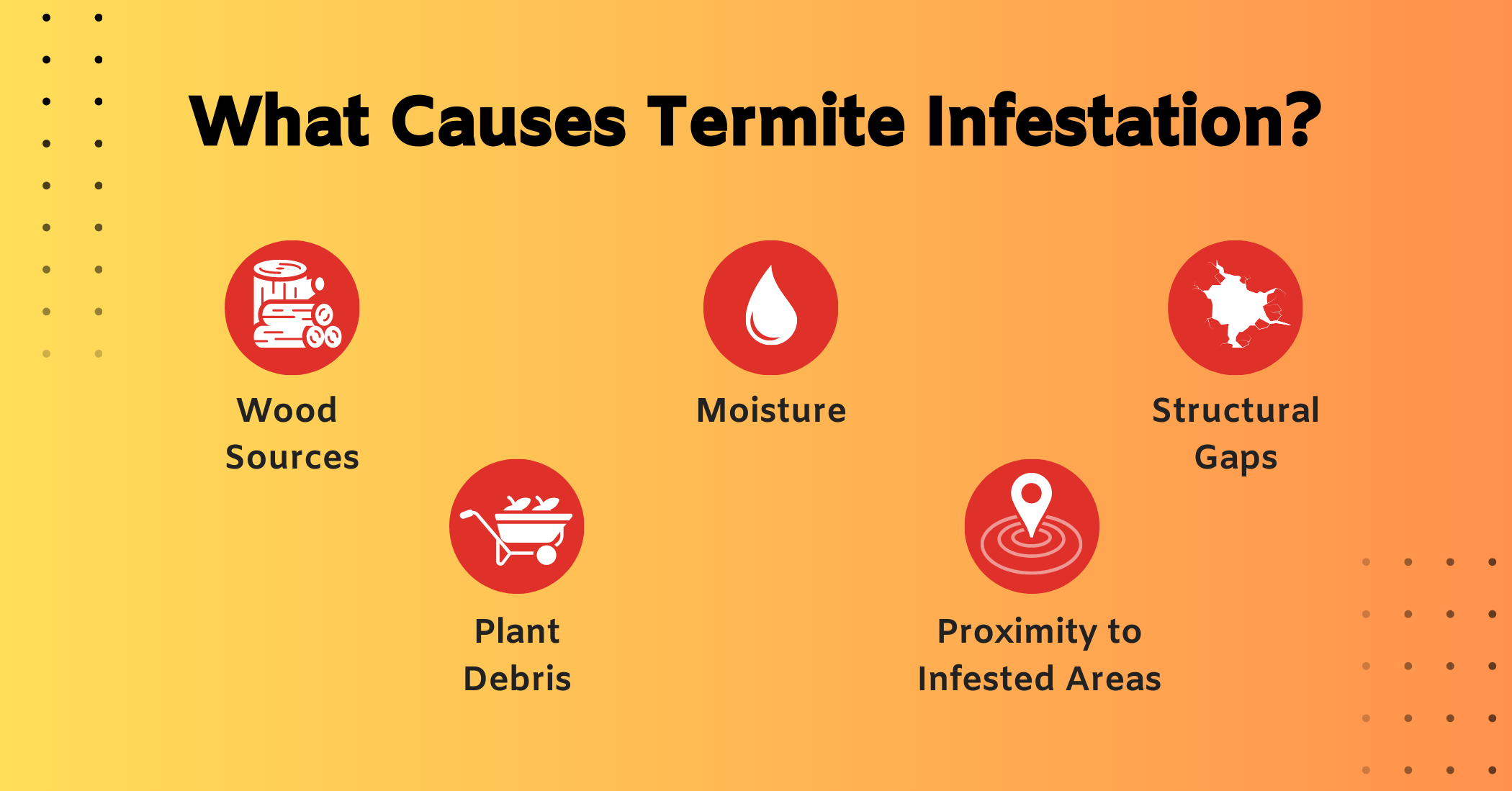
Termites are tiny creatures but can cause massive damage to our homes. Have you ever wondered why they infest your spaces? Here are the top 5 reasons:
- Wood Sources: Termites are primarily attracted to wood. Homes with abundant wooden structures, especially those in direct contact with the soil, are at higher risk.
- Moisture: Moist environments are conducive for termite activity. Areas with water damage, leaks, or high humidity can attract these pests.
- Structural Gaps: Homes with cracks, crevices, or gaps can provide entry points for termites, allowing them to access and infest the structure.
- Plant Debris: Accumulated plant matter, such as dead trees, logs, or mulch, can serve as a food source and habitat for termites.
- Proximity to Infested Areas: If nearby properties or areas are infested with termites, there’s an increased likelihood that they might spread to adjacent locations.
What Are The Common Sites For Termite Infestations?
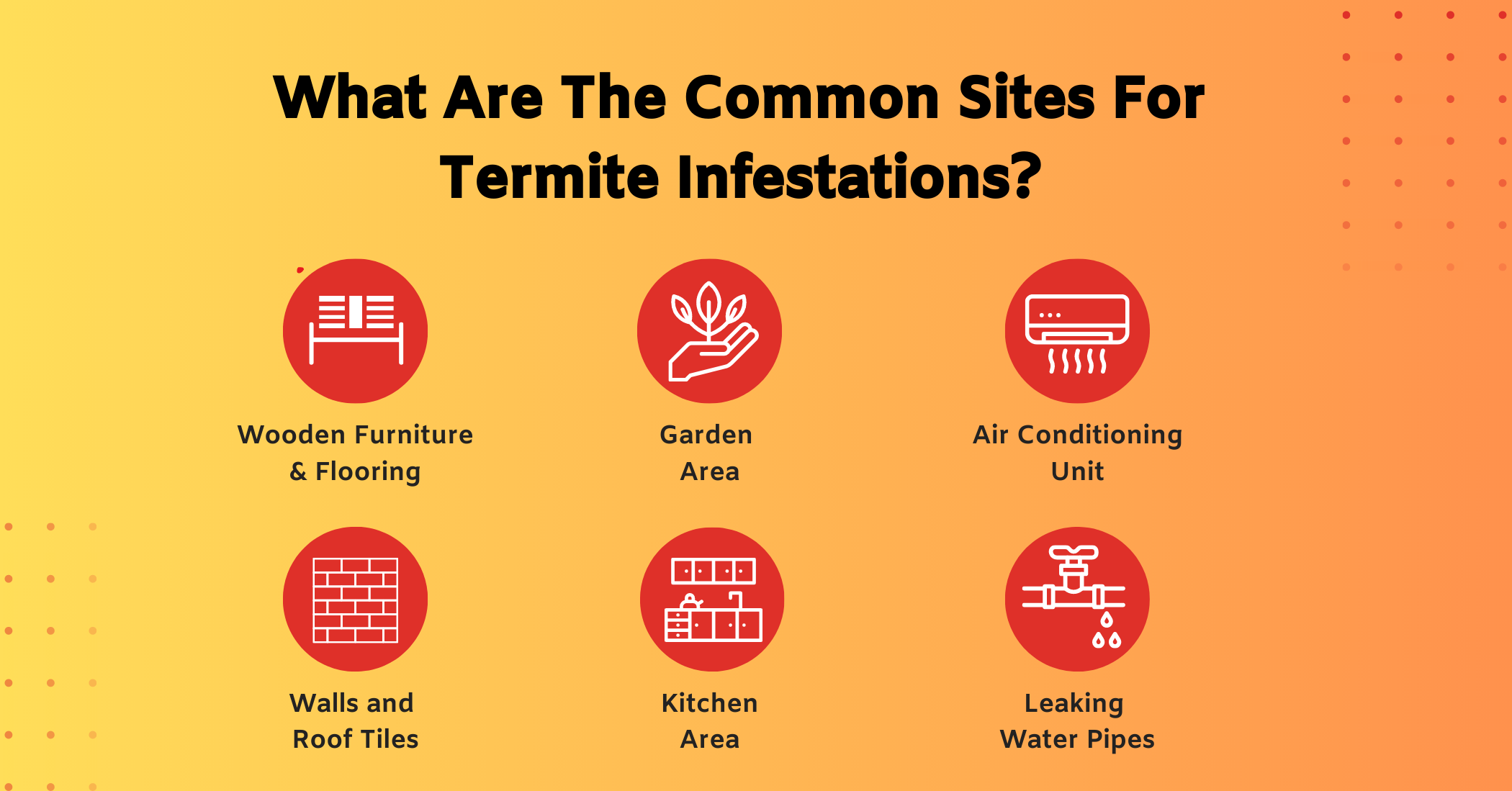
These are the common sites for termite infestations:
- Wooden Furniture and Flooring: Termites just can’t resist munching on wood. That’s why they tend to make themselves at home in wooden furniture and flooring, then spread all over the place!
- Garden Area: Termites, love to dig underground tunnels in garden areas. They just can’t resist infesting the soft garden soil outside your house. Dead tree stumps are actually a perfect hiding spot for termites.
- Air Conditioning Unit: Termites love to infest your air conditioning unit because they are fond of moist air, and they get the same inside your air conditioning unit.
- Walls and Roof Tiles: Damp walls and broken roof tiles can make your house a prime spot for termites to hang out.
- Kitchen: Termites tend to infest easily inside the kitchen doors, windows, and cabinets because they can easily find food in the doors, windows, and cabinets.
- Leaking Water Pipes: Termites, just like other pests, are attracted to water. So, it’s like an open invitation for them to make themselves at home.
Signs Of Termite Infestation
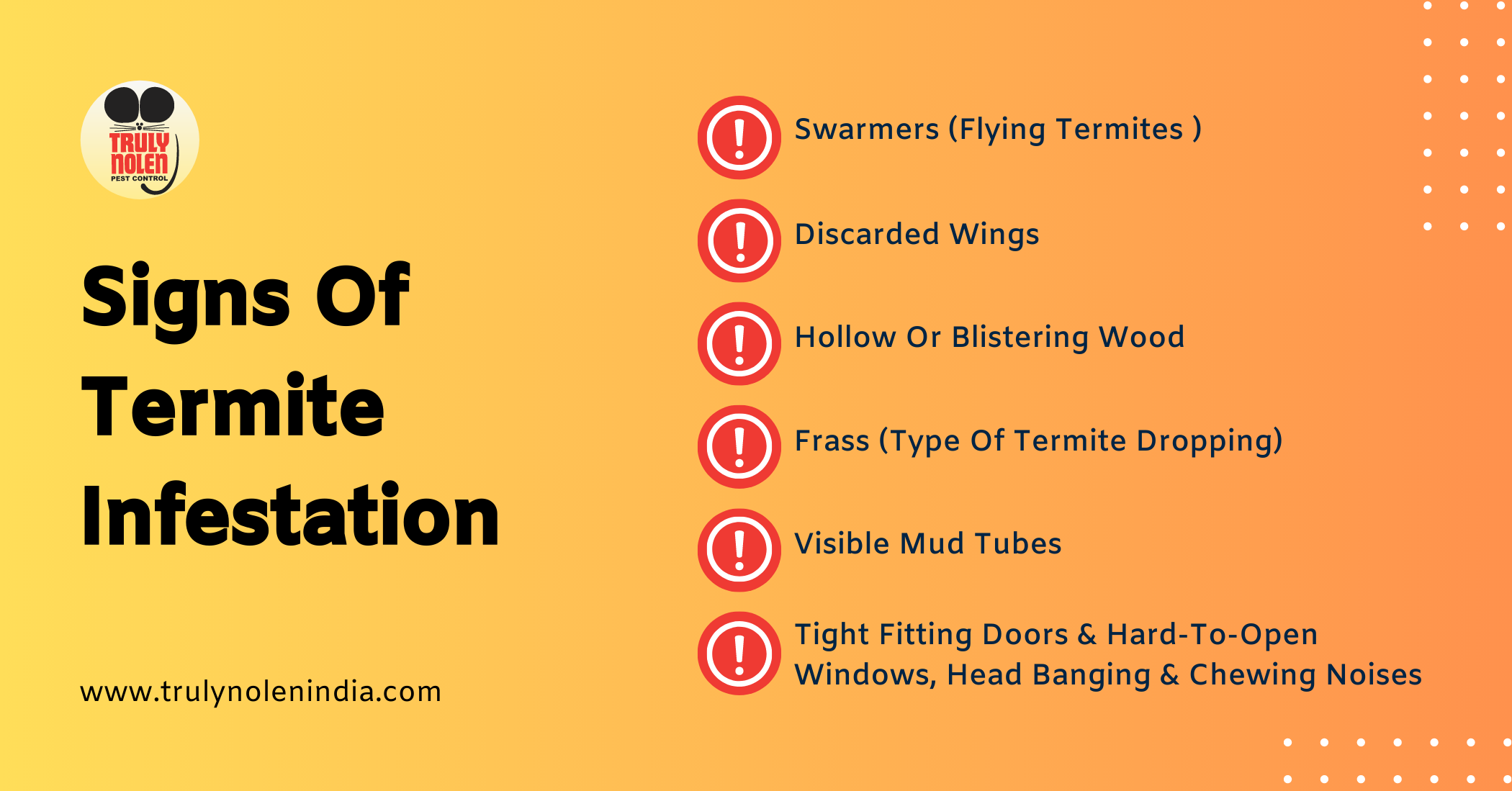
You can identify termite infestations by looking out for the following signs:
1. Swarmers (flying termites )
- Swarmers are often one of the initial indicators of a termite infestation. Swarmers are winged termites that come out of their nests in big groups
- Did you know that these flying termites are actually males and females who have ventured out of their nests in search of a suitable mate?
- Swarmers can be seen emerging outside but very near the building’s foundation. They emerge from a stump, log, pile of wood, or other sources out in the landscape.
2. Discarded wings
- Discarded wings that are left behind are another visible sign of a termite problem. After swarmers take flight, they shed their wings.
3. Hollow or blistering wood
- Termites tend to feed on wood from the inside out, leaving behind a thin layer of timber or even just the paint.
- When you gently knock or tap on an area that might have termite damage, you might notice that it sounds a bit hollow or papery. This happens when some or all of the timber inside has been eaten away.
- Some unexplained cracks on the internal walls could potentially be a sign of some termite activity going on inside.
- Eating and tunneling through door and window frames can sometimes cause the wood to bend, which might make it a bit challenging to open doors and windows.
- Termites can cause damage to laminated flooring and baseboards, too, causing blisters on flooring. If your floor feels a bit spongy and maybe springs a little more than usual, then there may be termite activity going on underneath the floor.
4. Frass (Type of termite dropping)
- Frass is actually a type of termite dropping that has a wood-like color. Sometimes, it can be mistaken for sawdust, especially if you’re not familiar with it.
- Drywood termites, unlike subterranean termites, don’t use their feces to construct their tunnels. Instead, they gently push it out of small holes near the entrances to their nest.
- This can cause some little black marks and look like a dark color powdery substance to appear around the area where they are infesting.
5. Visible Mud tubes
- Mud tubes actually serve as a form of protection for those little termites.
- Subterranean termite species usually construct these tubes using a mixture of soil and termite droppings. These tubes help them maintain the necessary moisture level
6. Tight fitting doors and hard-to-open windows, head banging and chewing noises
- When termites eat and tunnel through door and window frames, they produce moisture that can cause the wood to warp. This can make it difficult to open doors and windows.
- They have a unique way of communicating with their fellow termites. They either gently tap their heads against the wood or shake their bodies to signal danger. You can hear head banging and chewing noises if you place your head close to the door.
How Do We Identify Termite Damage?
Detecting signs of termite colonies early is really important to minimize the damage they can cause, but it can be quite challenging. But there are certain signs to identify their damage.
- You See Tiny Pinholes
- You Notice Mud Tubes traveling up the foundation wall, supporting piers or fascia boards.
- Your Wall Paint Is Bubbling or Flaking
- Your Wall Sounds Hollow
- You See Dust Near the Bottom of the Wall
- In wallpaper, paint, or other surfaces, you notice narrow,roof,ken winding lines, or sunken areas.
- You notice odd-shaped formations of dried mud sprouting from the walls or ceiling in late spring.
- You notice structural problems such as a sagging floor or roof or more obvious problems like a broken door frame.
- Your Foundation Has Shifted
What To Do If You Have Termites?
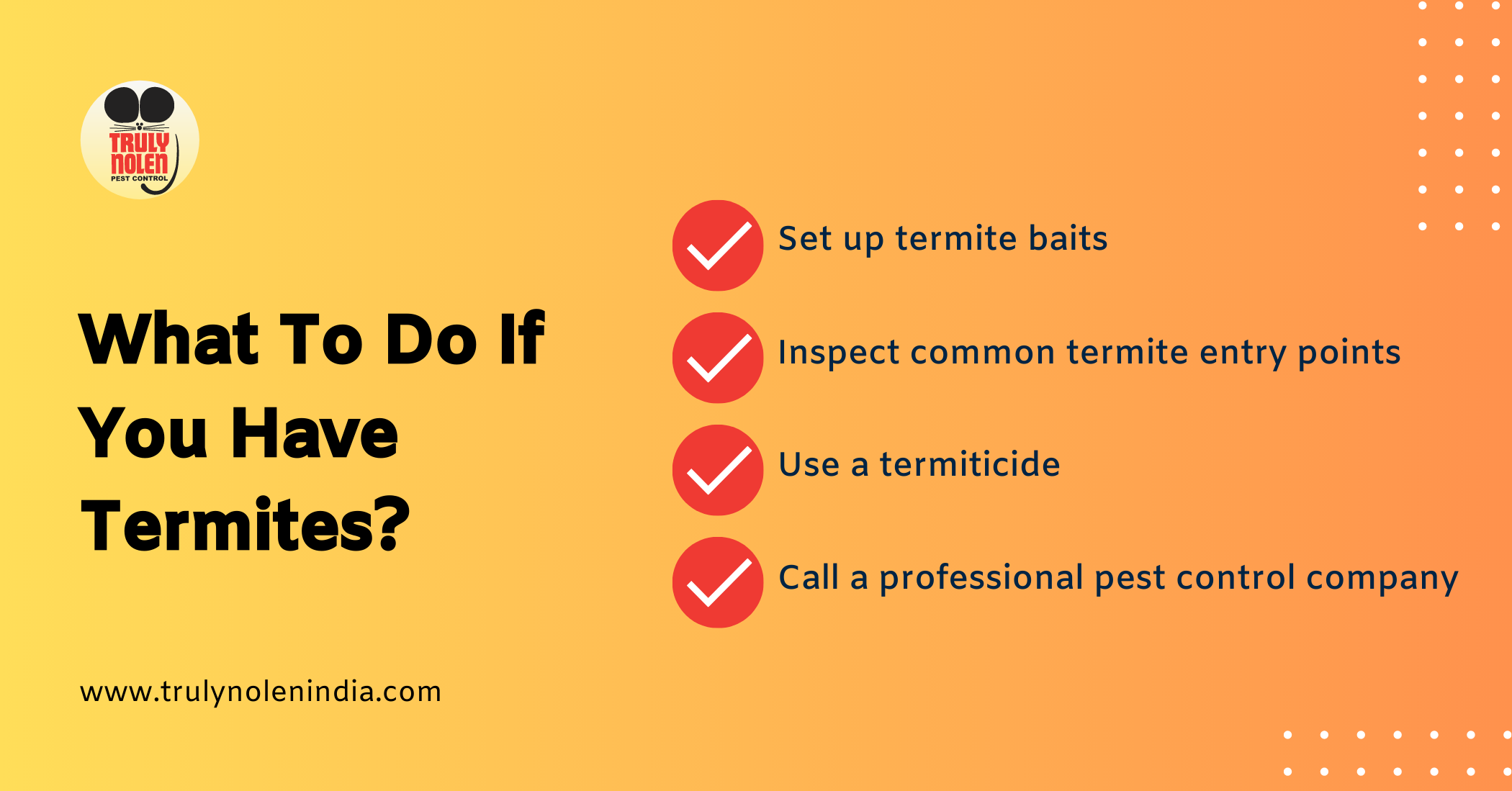
It’s important to pay attention to any early signs of termites, as ignoring them can lead to serious damage later on. Here are some recommendations for what you can do if you notice any signs of a problem. These can be both preventive and precautionary measures to tackle termite infestations.
- Set up termite baits: Place the termite baits around your home in areas where you suspect the infestation might be. These baits are designed to attract termites to the highly effective poison.
- Inspect common termite entry points: Regularly check these spots for any signs of termites. Remove any standing water in the area. To prevent termites, treat the wood with termite prevention methods such as soil treatments that repel these pests.
- Use a termiticide: Termiticide is a helpful chemical that can be sprayed into cracks or inside walls to eliminate termites.
- Call a professional pest control company: Call in professionals when it comes to removing termites. The cost of termite treatment is definitely worth it.
You can learn more about dealing with termites by reading our blog on how to get rid of termites.
In a nutshell, successfully dealing with termites involves a few key steps: first, figuring out what type of termites you’re dealing with, then using effective treatments, and finally, taking preventative measures to keep them from coming back. If you think you have termites, it’s a good idea to reach out to a pest control professional, such as Truly Pest Solution. They can assess the situation and recommend the best treatment options for you.
Guard Your Property Against Termites With Truly Pest Solution!
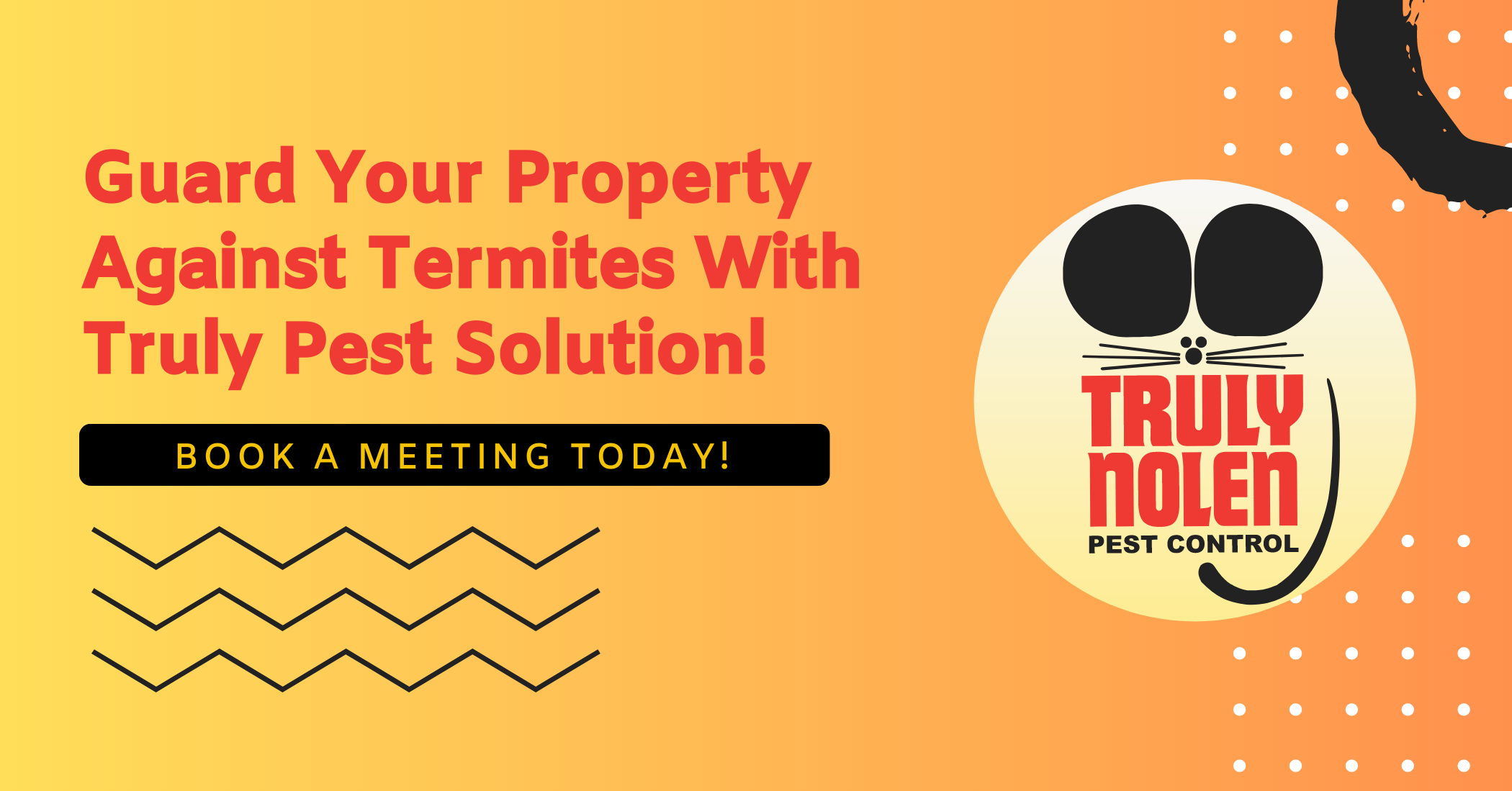
Searching for a reliable solution to combat those pesky termites invading your precious homes and offices? Well, look no further because Truly Pest Solution’s Truly Termite Control plan is here to save the day.
Our cutting-edge and all-encompassing termite control program is effective against those pesky critters. Our expert team will swiftly detect and treat any signs of infestation, creating a safe environment for you and your loved ones.
In addition, we also provide the best pre construction anti termite treatment to ensure safety from termites from the onset.
Stay one step ahead of termites with Truly Pest Solution. If you are experiencing a severe termite infestation or find it challenging to manage the problem on your own, reach out to us.
Contact us and Book a Meeting now!
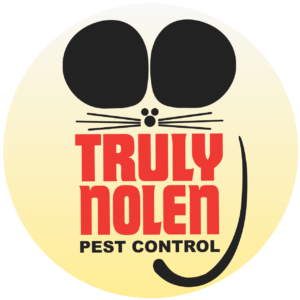
Leave a Reply